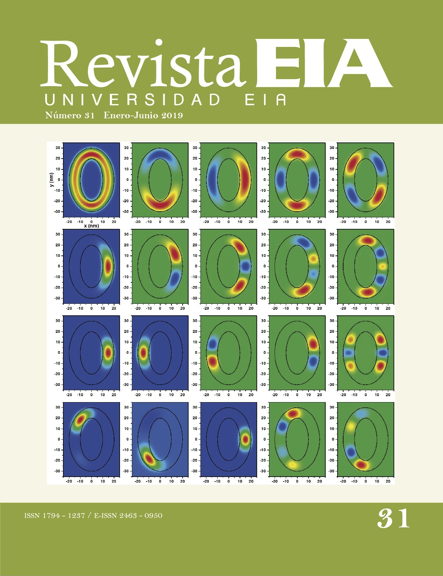Fostering Motivation and Improving Student Performance in an introductory programming course: An Integrated Teaching Approach
Fostering Motivation and Improving Student Performance in an introductory programming course: An Integrated Teaching Approach

Declaración del copyright
Los autores ceden en exclusiva a la Universidad EIA, con facultad de cesión a terceros, todos los derechos de explotación que deriven de los trabajos que sean aceptados para su publicación en la Revista EIA, así como en cualquier producto derivados de la misma y, en particular, los de reproducción, distribución, comunicación pública (incluida la puesta a disposición interactiva) y transformación (incluidas la adaptación, la modificación y, en su caso, la traducción), para todas las modalidades de explotación (a título enunciativo y no limitativo: en formato papel, electrónico, on-line, soporte informático o audiovisual, así como en cualquier otro formato, incluso con finalidad promocional o publicitaria y/o para la realización de productos derivados), para un ámbito territorial mundial y para toda la duración legal de los derechos prevista en el vigente texto difundido de la Ley de Propiedad Intelectual. Esta cesión la realizarán los autores sin derecho a ningún tipo de remuneración o indemnización.
La autorización conferida a la Revista EIA estará vigente a partir de la fecha en que se incluye en el volumen y número respectivo en el Sistema Open Journal Systems de la Revista EIA, así como en las diferentes bases e índices de datos en que se encuentra indexada la publicación.
Todos los contenidos de la Revista EIA, están publicados bajo la Licencia Creative Commons Atribución-NoComercial-NoDerivativa 4.0 Internacional
Mostrar biografía de los autores
Visitas del artículo 794 | Visitas PDF 496
Descargas
- Ali, A. and Smith, D. (2014) Teaching an Introductory Programming Language in a General Education Course, Proceedings of the 2008 International Conference on Frontiers in Education: Computer Science and Computer Engineering, FECS 2008, 13, pp. 236–240. Available at: http://www.scopus.com/inward/record.url?eid=2-s2.0-62649122836&partnerID=40&md5=ed1302320017b959ae9f4c7e10972080.
- Alturki, R. (2016). Measuring and improving student performance in an introductory programming course. Informatics in Education, 15(2), 183.
- Aris, H. (2015, July). Improving students performance in introductory programming subject: A case study. In Computer Science & Education (ICCSE), 2015 10th International Conference on (pp. 657-662). IEEE.
- Bennedsen, J. and Caspersen, M. E. (2007). Failure rates in introductory programming, AcM SIGcSE Bulletin. ACM, 39(2), pp. 32–36.
- Chan Mow, I. T. (2008). Issues and difficulties in teaching novice computer programming, Innovative Techniques in Instruction Technology, E-Learning, E-Assessment, and Education, pp. 199–204. doi: 10.1007/978-1-4020-8739-4-36.
- Chapman, B. E. et al. (2015). Python as a First Programming Language for Biomedical Scientists, (Scipy), pp. 12–17.
- Chien-An L. YU-Tzu L., and Cheng-Chih Wu (2015). ¿Which programming language should students learn first?. International Conference on Learning and Teaching in Computing Engineering, Taiwan.
- Echeverría, L., Cobos, R., Machuca, L., and Claros, I. (2017). Using collaborative learning scenarios to teach programming to non-CS majors, Computer Applications in Engineering Education, (November 2016), pp. 719–731. doi: 10.1002/cae.21832.
- Enbody R.J., Punch W. (2009) Python CS1 as preparation for C++ CS2. Conference Paper in ACM SIGCSE Bulletin·Chattanooga, Tennessee, USA
- Furman B., Wertz E., (2010). A First Course in Computer Programming for Mechanical Engineers. Proceedings of 2010 IEEE/ASME International Conference on Mechatronic and Embedded Systems and Applications Pages 70-75.
- Gomes, A. and Mendes, A. (2015). A teacher’s view about introductory programming teaching and learning: Difficulties, strategies and motivations, Proceedings - Frontiers in Education Conference, FIE, 2015–February(February). doi: 10.1109/FIE.2014.7044086.
- Guo, P. (2014). Python is now the most popular introductory teaching language at top us universities, BLOG@ CACM, July, p. 47.
- Hoffbeck P., Dilon H., Albright., Lu W., Doughty T. (2016) Teaching programming in the context of solving engineering problems. Frontiers in Education Conference (FIE), IEEE. Pennsilvania, USA.
- Konecki, M. and Petrlic, M. (2014). Main problems of programming novices and the right course of action, in Central European Conference on Information and Intelligent Systems, p. 116.
- Koulouri, T., Lauria, S. and Macredie, R. D. (2014). Teaching Introductory Programming: A Quantitative Evaluation of Different Approaches, Trans. Comput. Educ., 14(4), p. 26:1–26:28. doi: 10.1145/2662412.
- Machuca, L. and Solarte Pabón, O. (2016). Improving Student Performance in a First Programming Course, in Proceedings of the 2016 ACM Conference on Innovation and Technology in Computer Science Education, p. 367.
- Mason, R., Cooper, G. and Raadt, M. De (2012). Trends in Introductory Programming Courses in Australian Universities – Languages, Environments and Pedagogy, 14th Australasian Computing Education Conference, pp. 33–42.
- Pears, a et al. (2007). A survey of literature on the teaching of introductory programming, SIGCSE Bulletin, 39(4), pp. 204–223. doi: 10.1080/08993400500150747.
- Salcedo, S. L. and Idrobo, A. M. O. (2011). New tools and methodologies for programming languages learning using the scribbler robot and Alice, Proceedings - Frontiers in Education Conference, FIE, pp. 1–6. doi: 10.1109/FIE.2011.6142923.
- Soares, A. (2011). Problem based learning in introduction to programming courses, Journal of Computing Sciences in Colleges. Consortium for Computing Sciences in Colleges, 27(1), p. 36.
- Stajano, F. (2000). Python in Education: Raising a Generation of Native Speakers, in 'Proceedings of the 8th International Python Conference'
- Van Roy P., Armstrong J., Flatt M., and Magnusson (2003). The role of Language Paradigms in Teaching programming. SIGCSE February 19-23, 2003, Reno, Nevada, USA. ACM 1-58113-648-X/03/0002.
- Vujošević-Janičić, M. and Tošić, D. (2008). The role of programming paradigms in the first programming courses, The Teaching of Mathematics. Društvo matematičara Srbije, (21), pp. 63–83.
- Yadin, A. (2011). Reducing the dropout rate in an introductory programming course, ACM inroads. ACM, 2(4), pp. 71–76.
- Zelle, J. M. (1999). Python as a First Programming Language, J. Comput. Sci. Coll., 29(6), pp. 153–154. Available at: http://dl.acm.org/citation.cfm?id=2602724.2602754.




